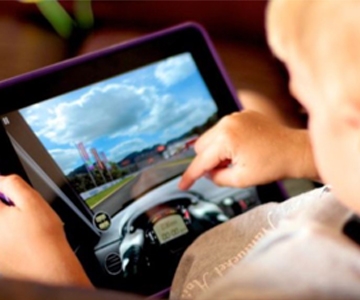
Description
Most parents worry how much time their child is spending on digital devices. Here are the facts about screen time.
What is blue light? Sunlight contains red, orange, yellow, green and blue light rays. Combined, this spectrum of coloured light rays creates what we call ‘white light’ or sunlight. Depending on where they fall on the spectrum, light rays have long wavelengths (with less energy) or short wavelengths (with more energy). Blue light is a high-energy visible light and has shorter wavelengths. It is known as blue light because it is on the violet-blue band of the spectrum. Blue light is naturally present in sunlight but is also something we can see from screens such as TVs, computers, smartphones and tablets.
Can blue light damage my child’s eyes? There is currently no scientific evidence that blue light causes damage to the eyes. However, there is evidence to suggest that carrying out near tasks, involving looking at something close-up, such as using mobile devices, screen time and reading a book, can increase eye strain for those who do this for long periods of time.
What is digital eye strain? Digital eye strain happens when a lot of time is spent using near vision, for example, reading on screen or playing online games. Digital eye strain does not cause permanent damage to your eyes but can be uncomfortable. One of the main symptoms is temporary blurred vision but other signs such as sore and tired eyes, dry eye and headaches are also associated with digital eye strain.
Can blue light affect my child’s sleep pattern? Using screens close to bedtime may contribute to poorer sleep, which may mean your child’s concentration levels are lower during the day. This may be because blue light is linked to the suppression of the hormone melatonin which makes us feel sleepy. However, there is a range of other factors linked to disrupted sleep.
Can blue light filtered lenses help? Some people report that lens coatings that filter blue light make their eyes feel more comfortable or are helpful before bed, but there is no clear scientific evidence to support this. There is also no evidence that these kinds of coatings prevent eye disease.
Why have I heard that blue light is harmful to eye health? Several studies have been carried out into the effects of blue light, and research in this area is still ongoing. Some past studies have revealed that exposure to blue light can lead to changes in animals’ eyes. However, because the time and intensity of exposure to blue light in these studies was far more than that of natural daylight and that of screens, this does not show that blue light is harmful to eyes.
Is there a link between screen time and short-sightedness? Short-sightedness, or myopia, is increasing throughout the world. Family history, ethnic background, environment (living indoors, in cities) and carrying out near tasks, such as screen use, have all been linked to the development of myopia. However, there is no clear evidence to suggest that screen time alone is the direct cause. But, there is good evidence to suggest that children who spend more time outdoors are at lower risk of developing short-sightedness.
Tips for keeping your child’s eyes healthy
• Get them outdoors — regular play and exercise can help prevent or reduce the development of myopia (short-sightedness). Studies show two hours of outdoor activity a day is ideal.
• Using night settings, if your device has them, may help children sleep by reducing the amount of blue light given off by the screen during night-time hours.
• Make sure digital devices are turned off at least an hour before bedtime.
• Book your child in for a sight test every two years, from the age of three, or more often if your optometrist recommends it.

